| Revision as of 01:39, 13 July 2022 editBerkBerk68 (talk | contribs)Extended confirmed users, Pending changes reviewers1,858 editsm Top of the article's scheme completely changed to achive consensus and WP:C-P.Tags: Reverted Visual edit← Previous edit | Revision as of 01:42, 13 July 2022 edit undoBerkBerk68 (talk | contribs)Extended confirmed users, Pending changes reviewers1,858 editsm internal links added.Tags: Reverted Visual editNext edit → | ||
| Line 9: | Line 9: | ||
| '''] history''' is the common history between today's ]. While the ] were the first state established under the name of Turk, there were many Turkic tribes and states before the Göktürks. | '''] history''' is the common history between today's ]. While the ] were the first state established under the name of Turk, there were many Turkic tribes and states before the Göktürks. | ||
| Most of the ] were descendants of ],<ref>{{Cite journal |last=Taşbaş |first=Erhan |date=2022-01-01 |title=Kinship in the Xiongnu Political System |url=https://dergipark.org.tr/tr/pub/jots/issue/66850/1034076 |journal=Journal of Old Turkic Studies |language= |volume=6 |issue=1 |pages=118–134 |doi=10.35236/jots.1034076}}</ref><ref>{{Cite journal |last=Lee |first=Joo-Yup |date=2016 |title=The Historical Meaning of the Term Turk and the Nature of the Turkic Identity of the Chinggisid and Timurid Elites in Post-Mongol Central Asia |url=https://www.jstor.org/stable/10.13173/centasiaj.59.1-2.0101 |journal=Central Asiatic Journal |volume=59 |issue=1-2 |pages=101–132 |doi=10.13173/centasiaj.59.1-2.0101 |issn=0008-9192}}</ref> a tribal confederation of nomadic peoples located at ].<ref>{{cite web |title=Xiongnu People |url=http://global.britannica.com/topic/Xiongnu |url-status=dead |archive-url=https://web.archive.org/web/20200311191625/https://global.britannica.com/topic/Xiongnu |archive-date=11 March 2020 |access-date=25 July 2015 |website=britannica.com |publisher=Encyclopædia Britannica}}</ref> According to some fragmentary information in the Chinese historical records, The Xiongnu are from the Turkic background rather than Mongolic,<ref>{{Cite journal |last=Lee |first=Joo-Yup |last2=Kuang |first2=Shuntu |date=2017 |title=A Comparative Analysis of Chinese Historical Sources and Y-DNA Studies with Regard to the Early and Medieval Turkic Peoples |url=https://www.jstor.org/stable/26572263 |journal=Inner Asia |volume=19 |issue=2 |pages=197–239 |issn=1464-8172}}</ref> together with the emphasis of Ashina clan's Xiongnu origin.<ref name="Zhou50">] et al., '']'', ] {{in lang|zh}}</ref><ref name="Northern99">] (李延寿), '']'', ] {{in lang|zh}}</ref><ref>'']'', vol. 215 upper. "突厥阿史那氏, 蓋古匈奴北部也." "The Ashina family of the Turk probably were the northern tribes of the ancient Xiongnu." translated by Xu (2005)</ref><ref>Xu Elina-Qian, , University of Helsinki, 2005</ref> however, despite the claims of Chinese records, the ethnicity of the Xiongnu are uncertain—a Turkic origin has been proposed for them{{sfn|Hucker|1975|p=136}}<ref>{{cite web |last1=Savelyev |first1=Alexander |last2=Jeong |first2=Choongwon |date=May 10, 2020 |title=Early nomads of the Eastern Steppe and their tentative connections in the West |url=https://doi.org/10.1017/ehs.2020.18 |website=Cambridge |quote=The predominant part of the Xiongnu population is likely to have spoken Turkic (Late Proto-Turkic, to be more precise).}}</ref> as well as others, such as a ],<ref name="Harmatta488">{{harvnb|Harmatta|1994|p=488}}: "Their royal tribes and kings (''shan-yü'') bore Iranian names and all the Hsiung-nu words noted by the Chinese can be explained from an Iranian language of Saka type. It is therefore clear that the majority of Hsiung-nu tribes spoke an Eastern Iranian language."</ref>{{sfn|Bailey|1985|pp=21–45}}{{sfn|Jankowski|2006|pp=26–27}} ],<ref name="Tumen">{{cite journal |vauthors=Tumen D |date=February 2011 |title=Anthropology of Archaeological Populations from Northeast Asia |url=http://user.dankook.ac.kr/~oriental/Journal/pdf_new/49/11.pdf |url-status=dead |journal=Oriental Studies |publisher=Dankook University Institute of Oriental Studies |volume=49 |pages=25, 27 |archive-url=https://web.archive.org/web/20130729140858/http://user.dankook.ac.kr/~oriental/Journal/pdf_new/49/11.pdf |archive-date=2013-07-29}}</ref> ],{{sfn|Di Cosmo|2004|p=166}} ],{{sfn|Beckwith|2009|page=404–405 notes 51–52}}{{sfn|Adas|2001|p=88}}<ref>{{cite journal |last=Vovin |first=Alexander |year=2000 |title=Did the Xiongnu speak a Yeniseian language? |journal=Central Asiatic Journal |volume=44 |issue=1 |pages=87–104 |jstor=41928223}}</ref><ref>{{Cite journal |last=高晶一 |first=Jingyi Gao |date=2017 |script-title=zh:確定夏國及凱特人的語言為屬於漢語族和葉尼塞語系共同詞源 |trans-title=Xia and Ket Identified by Sinitic and Yeniseian Shared Etymologies |journal=Central Asiatic Journal |volume=60 |issue=1–2 |pages=51–58 |doi=10.13173/centasiaj.60.1-2.0051 |jstor=10.13173/centasiaj.60.1-2.0051}}</ref> or multi-ethnic.{{sfn|Geng|2005}} The Xiongnu were the first ] in the ] history. | Most of the ] were descendants of ],<ref>{{Cite journal |last=Taşbaş |first=Erhan |date=2022-01-01 |title=Kinship in the Xiongnu Political System |url=https://dergipark.org.tr/tr/pub/jots/issue/66850/1034076 |journal=Journal of Old Turkic Studies |language= |volume=6 |issue=1 |pages=118–134 |doi=10.35236/jots.1034076}}</ref><ref>{{Cite journal |last=Lee |first=Joo-Yup |date=2016 |title=The Historical Meaning of the Term Turk and the Nature of the Turkic Identity of the Chinggisid and Timurid Elites in Post-Mongol Central Asia |url=https://www.jstor.org/stable/10.13173/centasiaj.59.1-2.0101 |journal=Central Asiatic Journal |volume=59 |issue=1-2 |pages=101–132 |doi=10.13173/centasiaj.59.1-2.0101 |issn=0008-9192}}</ref> a tribal confederation of nomadic peoples located at ].<ref>{{cite web |title=Xiongnu People |url=http://global.britannica.com/topic/Xiongnu |url-status=dead |archive-url=https://web.archive.org/web/20200311191625/https://global.britannica.com/topic/Xiongnu |archive-date=11 March 2020 |access-date=25 July 2015 |website=britannica.com |publisher=Encyclopædia Britannica}}</ref> According to some fragmentary information in the Chinese historical records, The Xiongnu are from the Turkic background rather than ],<ref>{{Cite journal |last=Lee |first=Joo-Yup |last2=Kuang |first2=Shuntu |date=2017 |title=A Comparative Analysis of Chinese Historical Sources and Y-DNA Studies with Regard to the Early and Medieval Turkic Peoples |url=https://www.jstor.org/stable/26572263 |journal=Inner Asia |volume=19 |issue=2 |pages=197–239 |issn=1464-8172}}</ref> together with the emphasis of ] Xiongnu origin.<ref name="Zhou50">] et al., '']'', ] {{in lang|zh}}</ref><ref name="Northern99">] (李延寿), '']'', ] {{in lang|zh}}</ref><ref>'']'', vol. 215 upper. "突厥阿史那氏, 蓋古匈奴北部也." "The Ashina family of the Turk probably were the northern tribes of the ancient Xiongnu." translated by Xu (2005)</ref><ref>Xu Elina-Qian, , University of Helsinki, 2005</ref> however, despite the claims of Chinese records, the ethnicity of the Xiongnu are uncertain—a Turkic origin has been proposed for them{{sfn|Hucker|1975|p=136}}<ref>{{cite web |last1=Savelyev |first1=Alexander |last2=Jeong |first2=Choongwon |date=May 10, 2020 |title=Early nomads of the Eastern Steppe and their tentative connections in the West |url=https://doi.org/10.1017/ehs.2020.18 |website=Cambridge |quote=The predominant part of the Xiongnu population is likely to have spoken Turkic (Late Proto-Turkic, to be more precise).}}</ref> as well as others, such as a ],<ref name="Harmatta488">{{harvnb|Harmatta|1994|p=488}}: "Their royal tribes and kings (''shan-yü'') bore Iranian names and all the Hsiung-nu words noted by the Chinese can be explained from an Iranian language of Saka type. It is therefore clear that the majority of Hsiung-nu tribes spoke an Eastern Iranian language."</ref>{{sfn|Bailey|1985|pp=21–45}}{{sfn|Jankowski|2006|pp=26–27}} ],<ref name="Tumen">{{cite journal |vauthors=Tumen D |date=February 2011 |title=Anthropology of Archaeological Populations from Northeast Asia |url=http://user.dankook.ac.kr/~oriental/Journal/pdf_new/49/11.pdf |url-status=dead |journal=Oriental Studies |publisher=Dankook University Institute of Oriental Studies |volume=49 |pages=25, 27 |archive-url=https://web.archive.org/web/20130729140858/http://user.dankook.ac.kr/~oriental/Journal/pdf_new/49/11.pdf |archive-date=2013-07-29}}</ref> ],{{sfn|Di Cosmo|2004|p=166}} ],{{sfn|Beckwith|2009|page=404–405 notes 51–52}}{{sfn|Adas|2001|p=88}}<ref>{{cite journal |last=Vovin |first=Alexander |year=2000 |title=Did the Xiongnu speak a Yeniseian language? |journal=Central Asiatic Journal |volume=44 |issue=1 |pages=87–104 |jstor=41928223}}</ref><ref>{{Cite journal |last=高晶一 |first=Jingyi Gao |date=2017 |script-title=zh:確定夏國及凱特人的語言為屬於漢語族和葉尼塞語系共同詞源 |trans-title=Xia and Ket Identified by Sinitic and Yeniseian Shared Etymologies |journal=Central Asiatic Journal |volume=60 |issue=1–2 |pages=51–58 |doi=10.13173/centasiaj.60.1-2.0051 |jstor=10.13173/centasiaj.60.1-2.0051}}</ref> or multi-ethnic.{{sfn|Geng|2005}} The Xiongnu were the first ] in the ] history. | ||
| ] mural, ], 7th century CE, Mongolia.]] | ] mural, ], 7th century CE, Mongolia.]] | ||
| Although there are debates about its inception, the history of the Turks is an important part of ]. The history of all people that emerged in ] and ] has been affected by the movements of the Turks to some degree. Turks also played an important role in bringing ] to the ] and ] to the ]. Their own religion became the pioneer and defender of the foreign religions they adopted after ], and they helped their spread and development (], ], ], ], ] and ]). | Although there are debates about its inception, the history of the Turks is an important part of ]. The history of all people that emerged in ] and ] has been affected by the movements of the Turks to some degree. Turks also played an important role in bringing ] to the ] and ] to the ]. Their own religion became the pioneer and defender of the foreign religions they adopted after ], and they helped their spread and development (], ], ], ], ] and ]). | ||
Revision as of 01:42, 13 July 2022
History of the Turkic peoplesThis article has multiple issues. Please help improve it or discuss these issues on the talk page. (Learn how and when to remove these messages)
|
Turkic history is the common history between today's Turkic peoples. While the Göktürks were the first state established under the name of Turk, there were many Turkic tribes and states before the Göktürks.
Most of the Göktürk Tribes were descendants of Xiongnu Empire, a tribal confederation of nomadic peoples located at Inner Asia. According to some fragmentary information in the Chinese historical records, The Xiongnu are from the Turkic background rather than Mongolic, together with the emphasis of Ashina clan's Xiongnu origin. however, despite the claims of Chinese records, the ethnicity of the Xiongnu are uncertain—a Turkic origin has been proposed for them as well as others, such as a Iranian, Mongolic, Uralic, Yeniseian, or multi-ethnic. The Xiongnu were the first nomadic empire-builders in the Inner Asian history.

Although there are debates about its inception, the history of the Turks is an important part of world history. The history of all people that emerged in Eurasia and North Africa has been affected by the movements of the Turks to some degree. Turks also played an important role in bringing Eastern cultures to the West and Western cultures to the East. Their own religion became the pioneer and defender of the foreign religions they adopted after Tengrism, and they helped their spread and development (Mani religion, Judaism, Buddhism, Orthodox, Nestorian Christianity and Islam).
The beginning of Turkic history
The nationalization process of human communities living on earth begins with their transition from hunter-gatherer to farmer-herder. It is thought that the human communities that formed the Turks started sheep breeding in 6000 BC. This date can be accepted as the beginning of the nomadic Turkic culture.

3rd century BC
- 312 BC: Founding of the Great Hun State (Hiung-nu) and Northern Chance War between China and Hiung-nu.
- 240 BC: Great Wall of China built to protect the nation against Inner Asian nomads.
- 209 BC: Death of Teoman (leader of the Hiung-nu), and Mete becomes the leader of the Hiung-nu .
- 201 BC: First mentioning of the name "Kyrgyz" in history.
- 201 BC: Siege of Peking

2nd century BC
- 187 BC: Battle of Baideng between China and Hiung-nu
- 177 BC - 165 BC: Yuezhi expulsion from Kansu to Bactria by the Hiung-nu and annihilation of the Bactrian Empire
- 177 BC - 165 BC: Hiung-nu incursions into China
- 138 BC-126 BC: Sino-Iranian relations established
- 2nd century BC: Asian Hun State (Great Hun State) collapsed

1st century BC
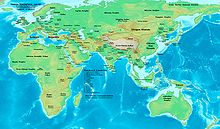

1st century
- 48: Hiung-nu split into two (Northern Hiung-nu and Southern Hiung-nu)
- 93: The Hiung-nu are defeated by the Xianbei
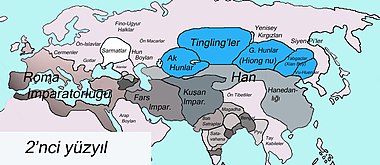
2nd century
- Hun presence in the Lower Volga (north of the Caspian Sea)

3rd century

4th century
- 304-351: Hiung-nu kingdoms in northern China (Han Zhao, Hou Zhao)
- 388-392: Zhai Wei kingdom in northern China
- 374-375: European Huns crossing the Don River
- 386-409: Northern Wei in Northern China
- 395: Migration Period
5th century
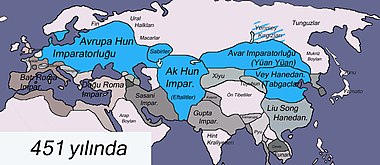
- 402: Founding of Rouran Khaganate
- 407-431: Hiung-nu kingdom (Xia) in northern China
- 422: Capture of Luoyang by the Northern Wei
- 427: Agreement between the Romans and Huns
- 434: Treaty of Margus between Byzantium and Huns
- 440: Beginning of the Hephthalite invasions
- 451: Attila in Gaul (modern day France)
- 452: Attila's expedition to Rome and his meeting with Pope Leo I
- 480: Pre-Bulgarians between the Caspian Sea and the Danube
- 480: Hephthalites helping Sassanids in the Mazdek Revolts
Middle Ages/Turks

6th century

- 531-578: The erection of the Fortifications of Derbent by the Persian Khosrau
- 534: Disintegration of the Northern Wei
- 540: The re-emergence of the lost Central Asian Turks mentioned in the Ergenekon epic
- 552: Göktürks revolt against Rouran domination. Establishment of the First Turkic Khanate.
- 565: Defeat of the Hephthalites on their war with Göktürks.
- 582: Seperation of the First Turkic Khaganate.
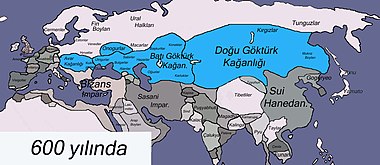
7th century
Central Asia
- 630: Eastern Turkic Khanate came under Chinese domination, Western Turkic Khanate came under Chinese influence.
- 639: Turkic prince Kürşat's attempt on a Turkic revolt in the Chinese emperor's palace.
- 659: Western Turkic Khaganate came under Chinese rule.
- 673-674: Arabs reach Transoxiana and besiege Bukhara.
- 674: The appearance of Turkic mercenaries (Mamluks) in Arab armies.
- 681: Second Turkic Khaganate established.
- 699: The establishment of the Turgesh Khanate (in present-day Kyrgyzstan)
Eastern Europe
- 616: First siege of Constantinople by Avars
- 621: Slavs uprising under Avars, accelerating Slavicization of the Balkans
- 626: The Avars besieged Istanbul for the second time and began to decline as a result of heavy losses.
- 626-627: Eastern Roman Emperor Heraclius' request for help from the Khazars, the Khazars' invasion of the Caucasus by defeating the Sassanids
- 630: Khazars' settlement in the Don-Volga basin, which was affiliated to the Western Turkic Khaganate, and the establishment of the Great Bulgarian Khanate in the north of the Black Sea.
- 651-652: War of the Arab Empire and the Khazars, who overthrew the Sassanids and captured all of Iran
- 678: The division of the Great Bulgarian Khanate by the westward pressure of the Khazars
- 680: The establishment of the First Bulgarian Empire by the Bulgarians who landed in the Balkans
Division of Bulgarians:
650 AD | 678 AD | 680 AD
8th century
Central Asia
- 705-715: Arabs take Transoxiana
- 720-735: Orkhon Monuments in Ötüken
- 721-737: Turgesh attack against Arabs
- 744: The destruction of the Second Turkic Khanate by the rebellious Uyghurs, Karluks and Basmyls
- 745: Establishment of the Uyghur Khaganate, independent khanate of Kimeks in what is today Kazakhstan
- 750: The strengthening of Arab-Turkish relations after the Abbasids came to the head of the Arab Empire
- 751: The entry of the Chinese into Central Asia, the defeat of the Chinese by the Arabs with the help of the Karluks in the Battle of Talas, the conversion of the Karluks to Islam
- 762: Uyghur Khaganate aided Tang dynasty in China in suppressing the An-Lu-Shan uprising
- 765: Adoption of the Mani religion by the Uyghur Khan Bögü
- 766: The dissolution of the Türgesh Khanate by the Karluks of the Uyghur Khanate, the establishment of the autonomous Karluk Khanate, the laying of the foundations of the Oghuz Yabgu State by the Oghuzes who escaped from the Karluks and migrated to the vicinity of the Caspian and Aral lakes.
- 789-795: Fight for the throne and decline in the Uyghur Khaganate
Eastern Europe
- 713-737: Khazar-Arab War, Khazar loss of Caucasus
- 716: The first written agreement of the Danube Bulgarian Khanate with the Byzantine Empire and the start of taxation
- 717-718: Aid of the Bulgarians to Byzantium against the Arab Siege of Constantinople
- 740: Adoption of Judaism as the official religion of the Khazars
- 745-775: Bulgarian-Byzantine relations tense
- 764: Invasion of the Caucasus and western Iran by the Khazars, defeating the Abbasids
- 780: Founding of Volga Bulgaria
- 792: After the Battle of Markeli, Byzantium began to pay taxes to the Bulgarians again.
- 796: Invasion of the Avar Khaganate by the Franks, stuck in the Hungarian plain

9th century

Central Asia
- 821: Uighurs repulse Tibetans
- 832: The Uighur Khaganate plunged into turmoil
- 840: The collapse of the Uyghur Khanate as a result of the attack of the Kyrgyz people, the establishment of the Kyrgyz Khanate, the escape of the Uyghurs to the southwest, the Karluks, who did not recognize the Kyrgyz sovereignty, declared their independence and laid the foundation of the Karakhanid State.
- 848: The establishment of the Kansu Uyghur Kingdom of the Uyghurs who migrated to the South West
- 856: The establishment of the Karahoca Uyghur Kingdom by another Uyghur branch that migrated to the southwest.
Eastern Europe
- 804: The collapse of the Avar Khaganate, which was dissolved as a result of the blows of the Franks and consequently, the attacks of the Danube Bulgarian State
- 811-814: The Danube Bulgarian State's defeat of the Byzantine Empire
- 860: The Russians, who expanded to the south, reached Kiev in the Khazar Khaganate.
- 861: Migration of Pechenegs around Sri Darya to the north of the Black Sea under the pressure of Oghuzes, Kimeks and Karluks
- 864-865: The Bulgarian King Boris I accepted Christianity, the Danube Bulgarians became completely Slavic and broke away from the Turkic world.
- 889: The advance of the Pechenegs in the north of the Black Sea to the west under the pressure of the Khazars and Kipchaks
- 892: The Pechenegs advancing to the west forced the Hungarians from the Dnieper to migrate beyond the Carpathians, forming an agreement with the Byzantine Empire.
Asia and Africa
- 833-842: The increasing influence of Turkish slave soldiers in the Abbasid palace during Caliph Mutasim's reign
- 836: The relocation of the Abbasid capital from Baghdad to Samerra, where the Turkish slave garrison was located
- 868: Tulunid sovereignty over Egypt, Syria, Palestine and the north of Iraq but still remain within the Abbasid caliphate
10th century
Central Asia
- 923: The establishment of the Later Tang dynasty by the Shatuo Turks, descended from the Göktürks, in the north of China
- 924: The destruction of the Kyrgyz State by the Mongol Khtai, the end of the Turkic rule in Ötüken, the migration of the Kyrgyz to their present homeland.
- 934: With Satuk Buğra Khan's acceptance of Islam, the Karakhanid State adopt the religion of Islam
- 979: The Shatuo Turks came under the domination of the Northern Song Dynasty, the Turkic presence in the north of China melted.
- 990-999: The Karakhanid State destroyed the Samanid Empire, Transoxiana came under Turkic rule after 300 years.
Eastern Europe
- 920: Russo-Pecheneg War
- 922: Visit of Ibn Fadlan as ambassador to the Bulgarian Khanate of İdil, which converted to Islam
- 940: Russian-Byzantine alliance against Khazars, Khazars lose Crimea
- 943: Pechenegs allied with the Russians against the Byzantine Empire
- 965: Oghuz Yabgu State's alliance with the Russians against the Khazars
- 968-972: Pechenegs' attacks on the Russians
- 969: The capture of the Khazar capital by the Russian king Svyatoslav I, the withdrawal of the Khazars to the north of the Caucasus
- 985: Oghuz Yabgu State's alliance with the Russians against the Volga Bulgarian State
- 986: Settlements of the Seljuks in the south of Kazakhstan by breaking away from the Oghuz Yabgu State
Asia and Africa
- 905: The end of the Tulunid dynasty in Egypt by the Abbasids
- 935: Another Turkic dynasty, the Akshites, seized power in Egypt and dominated Syria, Palestine, Hejaz and northern Sudan.
- 963: Establishment of Ghazni State, expansion of Turkish sovereignty to Afghanistan and Pakistan
- 969: Termination of the rule of the Akshites by the Fatimid State
11th century
Central Asia
- 1036: The Kansu Uyghur Kingdom came under the rule of the Mongolian Tankut Kingdom.
- 1042: The division of the Karakhanid State into East and West
- 1050: The destruction of the Kimek Khanate by the invasion of the Kipchaks
- 1089: Samarkand-centered Western Karakhanid State entered the Seljuk nationality
- 1091: The Eastern Karakhanid State, based in Kashgar, became subject to the Seljuks.
- 1092: As a result of the Great Seljuk State being dragged into internal turmoil, the two Karakhanid states became independent again.
Eastern Europe
- 1016: The destruction of the Khazar Khaganate by the Russians and the Byzantine Empire
- 1037: Settlement of Pechenegs defeated by the Russians in Romania
- 1061-1068: The Kipchaks, who defeated the Russians, captured the north of the Black Sea and Ukraine
- 1091: After the Battle of Manzikert, the Pechenegs, who attacked the Byzantine Empire, which was in turmoil, were destroyed by the Byzantine-Kipchak alliance around Enez.
- 1093: Kipchaks' decisive defeat of the Russians
Asia
- 1038: Establishment of the Seljuk State in Khorasan
- 1040: In the Battle of Dandanakan, the Seljuks defeated the Ghaznavids and spread towards Iran
- 1048: The Seljuks, who defeated the Byzantine-Georgian alliance at the Battle of Pasinler, entered Eastern Anatolia
- 1055: Seljuks conquer Baghdad and seize the Abbasid state
- 1064: Seljuks conquer Ani Castle and break the Armenian-Georgian resistance
- 1071: The Seljuks, who defeated the Byzantine Empire at the Battle of Manzikert, spread to Anatolia.
- 1072: Establishment of Danishmend Principality in Sivas (subordinate to Great Seljuks)
- 1077: Establishment of the Anatolian Seljuk State whose capital is Iznik (subordinate to the Great Seljuks)
- 1081: The construction of the navy on the Aegean coast of the Çaka Principality and the establishment of the Turkish Naval Forces
- 1085: Establishment of the Syrian Seljuk State
- 1092: As a result of the murder of Sultan Melikşah by the Order of Assassins, the Great Seljuk State was dragged into internal turmoil
- 1096: The destruction of the pioneers of the First Crusade by the Anatolian Seljuk State in Iznik
- 1096-1099: As a result of the First Crusade, Iznik and Western Anatolia were taken back by Byzantium, and Crusader statelets were formed on the Syrian and Palestinian coasts.
South Asia
- 1001-1027: The expeditions of Mahmud of Ghazni, the Khan of the Ghazni State, to India, resulted in the spread of Turkish sovereignty and Islam to the north of India and Bangladesh
- 1037-1059: The struggle of the Ghazni State with the Great Seljuk State, Khorasan and Iran being dominated by the Seljuks
- 1059: Peace treaty between Ghaznavids and Great Seljuks
- 1079-1080: Ghazni State's defeat of the Ghurid dynasty, who gained power in Afghanistan
12th century
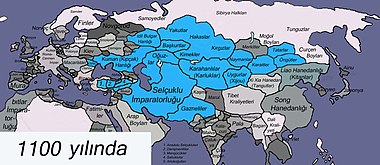
Asia
- 1100: The Danishmends defeated the Principality of Antakya in Malatya and definitively stopped the Crusaders' advance to Southeastern Anatolia.
- 1101: The defeat of the Anatolian Seljuk State and the Danishmends by the Crusaders in Kastamonu and Merzifon
- 1104: The Great Seljuk State defeated the Crusaders in Harran and blocked their advance to the Euphrates.
- 1104: Establishment of Börüoğulları Atabey in Damascus
- 1105-1128: Seljuks struggle against the Crusaders in Syria, the resistance of Damascus and Aleppo to the Crusader sieges
- 1127: Establishment of Zengi Atabeylik in Mosul
- 1127-1174: The struggle of the Zengid's with the Crusaders
- 1144: The conquest of Urfa by the Zengid's
- 1144: Establishment of Beytegin Atabeylik in Erbil
- 1147-1149: Organized after the fall of Urfa, in the Second Crusade, the Anatolian Seljuk State defeated the Crusaders' German army in Eskişehir and Ladik, the Zengid's repelled the Crusaders' Siege of Damascus
- 1150: The elimination of the Urfa County, one of the four Crusader states, by the Zengids
- 1154: Elimination of the Börioğulları Atabey by the Zengids
- 1173-1178: The Anatolian Seljuk State became the only power in Anatolia by capturing all the lands of the Danishmends.
- 1174-1183: Salahaddin Ayyubi's Ending Zengid sovereignty in Syria
- 1176: The defeat of the Byzantines by the Anatolian Seljuk State in the Battle of Myriokephalon, the finalization of the Seljuk sovereignty in Anatolia
- 1190: The invasion of Konya by the German arm of the Crusaders in the Third Crusade, the disintegration of the German army after the drowning of the German Emperor Frederick Barbarossa in Silifke
Iran and Central Asia
- 1092-1118: Internal turmoil and emergence of semi-independent atabeyliks within the Great Seljuk State
- 1132: The Mongolian Karahitays started to move towards Turkic lands by eliminating the Qocho.
- 1134: Karahitays overthrow the Eastern Karakhanids
- 1137: Karahitays overthrow the Western Karakhanids and demolish their dominance in Central Asia
- 1141: The collapse of the Great Seljuk State, which was defeated by the Karahitays in the Battle of Qatwan
- 1154-1157: Dissolution of the Great Seljuk State after the rebellion of the Oghuzs, the independence of the Khorezmshahs State
- 1182-1194: The Khwarazmshahs conquered Transoxiana by defeating Iran, Khorasan and Karahitays
- 1188: The elimination of the Kerman Seljuk State, one of the successors of the Great Seljuk State, by the Oghuzes
- 1194: The abolition of the Iraqi Seljuk State, one of the successors of the Great Seljuk State, by the Khwarazmshahs State.
South Asia
- 1117: The entry of the Great Seljuk army into Ghazni and the taxation of the Ghazni State
- 1119: Consolidation of the Ghazni State's dominance in northern India
- 1135: The Great Seljuk army re-entering Ghazni and taxing the Ghazni State again
- 1148-1151: Great destruction caused by the Ghurids after capturing Ghazni
- 1152: Great Seljuks liberation of Ghazni from Ghurids
- 1157-1163: With the disintegration of the Great Seljuk State, Ghazni and Afghanistan fell back into the hands of the Ghurids.
- 1186: The collapse of the Ghaznavid State, which continued to dominate Punjab, with Lahore as its capital, caused by the Ghurids.
Eastern Europe
- 1111-1116: Kipchak tribes defeated by the Russians
- 1123: Georgians supported by Kipchaks expel Great Seljuks from Tbilisi
- 1150: The Kipchaks regain their strength in the Dnieper.
- 1154: The Kipchaks, who repulsed the Russians, re-established their dominance around Kharkiv.
- 1157-1174: Conflicts between Volga Bulgarian and Russians
- 1174-1185: Military successes of the Kipchaks against the Russians

13th century
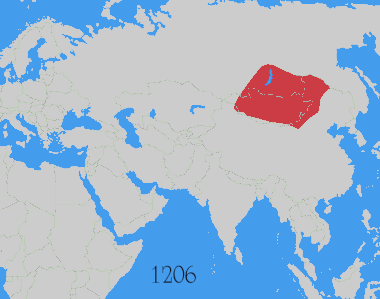
Asia and the Middle East
- 1202: The expansion of the Anatolian Seljuk State to Eastern Anatolia by eliminating the Saltuklu Principality
- 1207: The opening of the Anatolian Seljuk State to the Mediterranean with the conquest of Antalya
- 1214: The opening of the Anatolian Seljuk State to the Black Sea with the conquest of Sinop
- 1228: Elimination of the Mengüçlü Principality by the Anatolian Seljuk State
- 1230: The Khorezmshahs, who escaped from the Mongol invasion and advanced to Anatolia, were stopped by the Anatolian Seljuk State in the Battle of Yassıçemen
- 1239: The revolt of Baba İshak weakened the Anatolian Seljuk State.
- 1243: The defeat of the Anatolian Seljuk State by the Mongols in the Battle of Kösedağ
- 1250: The seizure of power by the Turkish-origin Mamluk Sultanate in Egypt, putting an end to the Ayyubids
- Nureddin Bey laid the foundations of the principality in Karaman
- 1299: Founding of the Ottoman State
Central Asia
- 1212: The elimination of the Karakhanids, who ruled in Fergana, by the Khwarazmshahs State.
South Asia
- 1206: Establishment of Delhi Sultanate by Turkish-origin slave commanders
- 1236: Delhi Sultanate's domination of all of northern India, Kashmir and Bangladesh
- 1290: Turkish-origin Halacians seized power in the Delhi Sultanate

The Chagatai Khanate has been completely Turkified since 1350.
14th century
- 1320-1424: Tughluk Dynasty in Delhi established and ruled most of the India.
- 1346: The Ottomans entered Europe.
- 1361: Conquest of Edirne by the Ottomans occured.
- 1370: Timur's seizure of power, establishment of Timurid Empire.
- 1382: Tokhtamysh leads the Golden Horde's Army and sets Moscow on fire.
- 1389: Battle of Kosovo: Ottoman domination in the Balkans
- 1389-1403: Reign of Bayezid
- 1398: Timur's military expedition to India

15th century

Asia
- 1402: Battle of Ankara between Timur and Bayezid I
- 1406: Re-emergence of Akkoyunlu and Karakoyunlu people on the stage of history
- 1453: Conquest of Istanbul by Mehmed the Conqueror
- 1453-1504: The golden age of the Akkoyunlu state.
Central Asia
- 1405: Timur's death
- 1405-1447: Arrival of Shahruh in Herat
- 1447-1449: Ulugh Beg
- 1456: Establishment of the Kazakh Khanate
South Asia
- 1414-1517: Delhi Sultanate's Turkic dynasty Iranianized
Eastern Europe
- 1430: Crimean Khanate formed
- 1445: Establishment of the Khanate of Kazan
- 1462-1505: Astrakhan Khanate created
- 1473: Sultan Husayn Bayqara: Timurid Renaissance
New Age
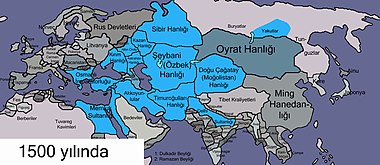

16th century
Eastern Europe
- 1502: The Crimean Khanate's destruction of the Golden Horde State
- 1552: Russia's annexation of the Kazan Khanate
- 1556: The annexation of the Astrakhan Khanate by Russia
- 1557: Russia's annexation of the Nogai Khanate
- 1571: Crimean Khanate burns Moscow
- 1580-1598: Russia's elimination of the Siberian Khanate
Central Asia
- 1500: Muhammed Shaybani and Uzbeks in Transoxiana
- 1510: The defeat of Muhammed Shaybani by Shah Ismail
Asia
- 1502: Ismail's establishment of the Safavid Dynasty in Iran
- 1514: The Battle of Çaldıran, the settlement of the Ottomans in Eastern Anatolia
- 1516: Battle of Ridaniye, Ottomans taking Syria and Palestine from the Mamluk State
- 1517: Ottoman domination in Hijaz
- 1534: Ottomans taking Iraq from Safavids
- 1538: Ottoman domination in Yemen
- 1551: Ottoman rule reaching Qatar and Oman
- 1578: Ottomans reaching the Caspian Sea
- 1590: Ottoman conquest of the entire Caucasus and Western Iran
South Asia
- 1526: Establishment of the Mughal Empire
Africa
- 1516: Establishment of Ottoman administration in Algeria
- 1516-1517: The Ottomans' destruction of the Mamluk State, Ottoman domination in Egypt
- 1551: Beginning of Ottoman rule in Libya
- 1557: Establishment of the Abyssinian Province by the Ottomans
- 1574: Beginning of Ottoman rule in Tunisia
- 1577: The spread of Ottoman rule in Fezzan
- 1576-1580: Ottoman influence in Morocco

17th century
Eastern Europe
- 1600: The defeat of the Siberian Khanate.
- 1606: The Treaty of Zitvatorok, which symbolized the Ottoman Empire's peak
- 1683: Siege of Vienna by the Ottomans.
- 1699: Treaty of Karlowitz. The decline of the Ottomans.
Asia
Central Asia
- 1605: Russian invasion of Yenisey
- 1615-1650: The struggle of the Yenisei Kyrgyz people against the Russians
- 1620: Russia's annexation of Yakut lands
- 1628: Dolgan's domination by Russia
- 1628-1630: Another Mongolian tribe, the Kalmyks, who were defeated by the Eastern Mongols, trampled on Kazakhstan and settled in the Volga region.
- 1634-1642: Russia's suppression of the Yakut revolts
- 1639: Russia's Reaching the Pacific Ocean
- 1680: Mongol capture East Turkestan, end of Chagatai Khanate
South Asia
18th century

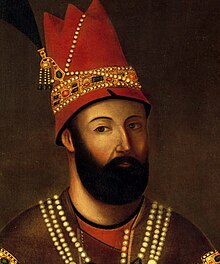
Eastern Europe
- 1742-1775: Pugachev War in Russia (Tatar uprising)
- 1783: Annexation of Crimea by the Russians.
Asia
- 1717-1730: Tulip Era of the Ottomans.
- 1736-1747: Nader Shah of Turkoman origin established Afsharid Empire, owning the identity of Turkic Afshar tribes.
- 1794: Qajar Dynasty founded in Iran by a Turk.
Central Asia
- 1709: Establishment of Kokand Khanate
- 1709-1718: The Dzungarian-Kazakh Khanate Conflict
- 1718: The division of the Kazakh Khanate into three kingdoms.
- 1721: Russia's annexation of Khakassia
- 1731: The minor part of the Kazakh Khanate came under Russian protection.
- 1740-1747: Iranian domination in the Khiva Khanate
- 1755-1759: The Manchu Dynasty, which took over the administration in China, seized East Turkestan which was in the hands of the Dzungarians
- 1755: Tuva under the rule of the Manchu Dynasty, which seized power in China
- 1756: Russia's capture of the Altai region
- 1785: Manghud's takeover of the Bukhara Khanate
Africa
- 1705: The Huseyni Dynasty appointed in Tunisia, which was a part of the Ottoman Empire
- 1798-1799: Egypt expedition of Napoleon Bonaparte. Turkish-French conflicts.
19th century
Eastern Europe
- 1829: Greece's independence
- 1878: Treaty of Berlin, Serbia, Montenegro, Romania gaining their independence, Bulgaria gaining autonomy
- 1881: Greek annexation of Thessaly
- 1881: Atatürk's birth
- 1885: Bulgaria's annexation of Eastern Rumelia
- 1813: Russia's annexation of Dagestan and Azerbaijan
- 1827: Russian domination of the Balkars
- 1828: Karachays' entry into Russian domination
- 1828: Russia's annexation of Yerevan and Nakhchivan
- 1829: Russia's annexation of Akhaltsikhe
- 1839: Tanzimat Edict in the Ottoman Empire
- 1876: The first constitution of the Ottoman Empire legislated.
Central Asia
- 1820: The Great Juz of the Kazakh Khanate came under the rule of the Kokand Khanate
- 1847: The lands of the Kazakh Khanate completely passed into the hands of Russia
- 1851-1854: The defeat of the Khiva Khanate to the Russians
- 1864: The start of Russian expeditions to West Turkestan
- 1865: Establishment of Kashgar Khanate in East Turkestan
- 1866: The Emirate of Bukhara came under Russian rule
- 1868: The Kokand Khanate came under Russian rule
- 1871: Russian occupation of Lake Balkhash
- 1873: The Khiva Khanate came under Russian rule
- 1876: Russia's annexation of the Khanate of Kokand
- 1877-1878: China's elimination of the Khanate of Kashgar
- 1881-1884: Russia's annexation of Turkmenistan
South Asia
- 1805: The Mughal State came under the auspices of the British who defeated the Maratha Confederation
- 1857: The British overthrow the Mughal State, the end of nine centuries of Turkish rule/existence in India
Africa
- 1807: British abolish slave trade, Royal Navy patrol around Africa to intercept slave ships
- 1822: Sudan's entry into Ottoman rule
- 1830-1842: French invasion of Algeria
- 1831-1840: Ottoman-Egyptian struggle, Egypt gaining autonomy
- 1869: Opening of the Suez Canal
- 1881: Second French invasion of Algeria
- 1882: British invasion of Egypt
- 1885: Italian invasion of Habesh
- 1885: End of Turkish rule in Sudan
- 1888: British invasion of Somalia, end of Turkish presence in Horn of Africa
20th century


- 1905: Beginning of Jadidism movements.
- 1910-1920: Alash Horda Government of Kazakhs and Kyrgyz
- 1911-1912: Invasion of Tripoli by Italy
- 1912: Balkan wars
- 1915-1916: Gallipoli Campaign
- 1917: Turkistan's declaration of autonomy
- 1918: The Armistice of Mudros was signed between Turkey and the Allied Powers.
- 1919-1922: The Turkish War of Independence took place.
- 1919-1928: Basmachi Uprising against the Soviet Union
- 1921-1944: Tuvan People's Republic
- 1922: Turkish victory over Greeks
- 1923: Turkey proclaimed to be a Republic
- 1932-1934: East Turkestan Islamic Republic of Uyghurs in China
- 1938: Ataturk's death
- 1944: Short-lived East Turkestan Republic established with the help of the Russian army
- 1955: Xinjiang Uyghur Autonomous Region: Declaring Xinjiang (East Turkistan) an autonomous region
- 1971: European withdrawal from Central Asia
- 1974: Turkish invasion of Cyprus
- 1983: The declaration of independence of the Turkish Republic of Northern Cyprus
- 1988: The beginning of the Azeri-Armenian conflict
- 1990: Soviet invasion of Baku
- 1991: The collapse of the USSR and the emergence of the Commonwealth of Independent States
- 1992: Admission of the CIS Turkic republics to the UN:
- 1992: The first Turkic Speaking Countries Summit was held in Ankara on 30 October 1992.
- 1993: The occupation of a region of Azerbaijan by the Armenians.
- 1993: In 1993, the Turkish Culture and Arts Joint Administration was established in Almaty, which provides cooperation in the fields of culture and arts of Turkic Speaking Countries.
- 1993: The first Turkic Congress, which was a cultural, economic and political forum and was attended by all Turkic states and communities and related communities.

21st century
- 2005: Tulip revolution in Kyrgyzstan.
- 2005: Kazakh leader Nursultan Nazarbayev's proposal to establish a common market in Central Asia in his address to the nation.
- 2005: Andijan massacre in Uzbekistan
- 2006: Baku-Tbilisi-Ceyhan pipeline put into service.
- 2007: The first meeting of riparian countries to determine the status of the Caspian Sea.
- 2008: Establishment of the Parliamentary Assembly of Turkic Speaking Countries between Turkey, Azerbaijan, Kazakhstan and Kyrgyzstan on 21 November 2008.
- 2009: Establishment of Organization of Turkic states.
- 2013: Gezi Park Protests
- 2016: Turkish coup attempt by Fethullah Gülen
Books

Turkish books
- İbrahim Kafesoğlu, Türk Millî Kültürü, Ankara, 1983.
- Zeki. Velidi Togan, Umumi Türk Tarihine Giriş, İstanbul, 1970.
- Faruk Sümer, Oğuzlar, İstanbul, 1980.
- Bahaeddin Ögel, İslamiyetten Önce Türk Kültür Tarihi, Ankara, 1962.
- Bahaeddin Ögel, Türk Kültür Tarihine Giriş, İstanbul, 1978.
- Bahaeddin Ögel, Büyük Hun İmparatorluğu Tarihi, Ankara, 1981.
- Çeçen Anıl, Tarihte Türk Devletleri, İstanbul, 1986.
- O. Esad Arseven, Türk Sanat Tarihi, İstanbul, 1955.
- Muharrem Ergin, Orhun Abideleri, İstanbul, 1977.
- Erol Güngör, Tarihte Türkler, İstanbul, 1989.
- Abdülkadir İnan, Eski Türk Dini Tarihi, İstanbul, 1976.
- A. Nimet Kurat, Karadeniz Kuzeyindeki Türk Kavimleri ve Devletleri, Ankara, 1972.
- Hüseyin Namık Orkun, Eski Türk Yazıtları, İstanbul, 1986.
- Hüseyin Namık Orkun, Türk Tarihi, Ankara, 1946.
- Osman Turan, Türk Cihan Hakimiyeti Mefrukesi Tarihi, İstanbul, 1978.
- Bahaeddin Ögel, Türk Mitolojisi, Ankara, 1971.
- Yusuf Hikmet Bayur, Hindistan Tarihi, Ankara, 1946.
- İbrahim Kafesoğlu, Selçuklu Tarihi, İstanbul, 1972.
- İbrahim Kafesoğlu, Harzemşahlar Devleti Tarihi, Ankara, 1956.
- M. Altay Köymen, Büyük Selçuklu İmparatorluğu Tarihi, Ankara, 1954.
- Çağatay Uluçay, İlk Müslüman Türk Devletleri, İstanbul, 1977.
- Faruk Sümer, Karakoyunlular, Ankara, 1984.
- A.N. Kurat, Peçenek Tarihi, İstanbul, 1937.
- B. Yenilmez, Yenilmez, Rize, 2002.
English and foreign books
- R. Grousset, L'Empire des steppes, Paris, 1960 (Türkçe çevirisi: Reşat Uzmen-Bozkır İmparatorluğu, 1996.)
- DE. Guignes, Histoire generale des Huns des Turcs et des Mongols, Paris, 1756.
- Jean-Paul Roux, Historie des Turcs, 1984.
- Jean-Paul Roux, Timur, 1994.
- Fayard Paris, Historie des Turcs, 1984.
- D.Sinor, Aspects of Altaic Civilization, 1963.
- M. Barthold, Turkestan down to the Mongol Invansıon, Londra, 1968.
- E. Berl, Historie de l'Europe d'Attila a Tamerlan, Paris, 1946.
- M.A. Czaplıcka, The Turks of Central Asia in History and at the Present Day, Oxford, 1918.
- W. Eberhard, Kultur und Siedlung der Randvölker China, 1942.
- L. Hambis, La Haute-Asie, Paris, 1953.
- Hammer-Purgstall, Von, Historie de l'Empire ottoman depuis son origine jusqu!a nos jours, Paris, 1835.
- H.H. Howorth, History of the Mongols, Londra, 1876.
- Jean-Paul Roux, Türklerin Tarihi - Pasifikten Akdenize 2000 Yıl, 2004
See also
References
- Taşbaş, Erhan (2022-01-01). "Kinship in the Xiongnu Political System". Journal of Old Turkic Studies. 6 (1): 118–134. doi:10.35236/jots.1034076.
- Lee, Joo-Yup (2016). "The Historical Meaning of the Term Turk and the Nature of the Turkic Identity of the Chinggisid and Timurid Elites in Post-Mongol Central Asia". Central Asiatic Journal. 59 (1–2): 101–132. doi:10.13173/centasiaj.59.1-2.0101. ISSN 0008-9192.
- "Xiongnu People". britannica.com. Encyclopædia Britannica. Archived from the original on 11 March 2020. Retrieved 25 July 2015.
- Lee, Joo-Yup; Kuang, Shuntu (2017). "A Comparative Analysis of Chinese Historical Sources and Y-DNA Studies with Regard to the Early and Medieval Turkic Peoples". Inner Asia. 19 (2): 197–239. ISSN 1464-8172.
- Linghu Defen et al., Book of Zhou, Vol. 50. (in Chinese)
- Li Yanshou (李延寿), History of the Northern Dynasties, Vol. 99. (in Chinese)
- New Book of Tang, vol. 215 upper. "突厥阿史那氏, 蓋古匈奴北部也." "The Ashina family of the Turk probably were the northern tribes of the ancient Xiongnu." translated by Xu (2005)
- Xu Elina-Qian, Historical Development of the Pre-Dynastic Khitan, University of Helsinki, 2005
- Hucker 1975, p. 136.
- Savelyev, Alexander; Jeong, Choongwon (May 10, 2020). "Early nomads of the Eastern Steppe and their tentative connections in the West". Cambridge.
The predominant part of the Xiongnu population is likely to have spoken Turkic (Late Proto-Turkic, to be more precise).
- Harmatta 1994, p. 488: "Their royal tribes and kings (shan-yü) bore Iranian names and all the Hsiung-nu words noted by the Chinese can be explained from an Iranian language of Saka type. It is therefore clear that the majority of Hsiung-nu tribes spoke an Eastern Iranian language."
- Bailey 1985, pp. 21–45.
- Jankowski 2006, pp. 26–27.
- Tumen D (February 2011). "Anthropology of Archaeological Populations from Northeast Asia" (PDF). Oriental Studies. 49. Dankook University Institute of Oriental Studies: 25, 27. Archived from the original (PDF) on 2013-07-29.
- Di Cosmo 2004, p. 166.
- Beckwith 2009, p. 404–405 notes 51–52.
- Adas 2001, p. 88.
- Vovin, Alexander (2000). "Did the Xiongnu speak a Yeniseian language?". Central Asiatic Journal. 44 (1): 87–104. JSTOR 41928223.
- 高晶一, Jingyi Gao (2017). 確定夏國及凱特人的語言為屬於漢語族和葉尼塞語系共同詞源 [Xia and Ket Identified by Sinitic and Yeniseian Shared Etymologies]. Central Asiatic Journal. 60 (1–2): 51–58. doi:10.13173/centasiaj.60.1-2.0051. JSTOR 10.13173/centasiaj.60.1-2.0051.
- Geng 2005.
- Jared Diamond Tüfek, Mikrop ve Çelik, Tübıtak Yayınları, ISBN 975-403-271-81997
- Mirfatih Zekiyev, Türklerin ve Tatarların Kökeni, s. 143-178, Selenge Yayınları, Ağustos 2007
- "Geçmişten Günümüze Türk Tarihi". Story And History (in Turkish). 18 December 2020. Retrieved 18 December 2020.
Sources
- Adas, Michael (2001). Agricultural and Pastoral Societies in Ancient and Classical History. American Historical Association/Temple University Press.
- Bailey, Harold W. (1985). Indo-Scythian Studies: being Khotanese Texts, VII. Cambridge University Press. JSTOR 312539. Retrieved 30 May 2015.
- Beckwith, Christopher I. (16 March 2009). Empires of the Silk Road: A History of Central Eurasia from the Bronze Age to the Present. Princeton University Press. ISBN 978-0-691-13589-2. Retrieved 30 May 2015.
- Di Cosmo, Nicola (2004). Ancient China and its Enemies: The Rise of Nomadic Power in East Asian History. Cambridge University Press. (First paperback edition)
- Geng, Shimin (2005). 阿尔泰共同语、匈奴语探讨 [On Altaic Common Language and Xiongnu Language]. Yu Yan Yu Fan Yi 语言与翻译(汉文版) [Language and Translation] (2). ISSN 1001-0823. OCLC 123501525. Archived from the original on 25 February 2012.
- Harmatta, János (1 January 1994). "Conclusion". In Harmatta, János (ed.). History of Civilizations of Central Asia: The Development of Sedentary and Nomadic Civilizations, 700 B. C. to A. D. 250. UNESCO. pp. 485–492. ISBN 978-9231028465. Retrieved 29 May 2015.
- Hucker, Charles O. (1975). China's Imperial Past: An Introduction to Chinese History and Culture. Stanford University Press. ISBN 0-8047-2353-2.
The proto-Turkic Hsiung-nu were now challenged by other alien groups — proto-Tibetans, proto-Mongol tribes called the Hsien-pi, and separate proto-Turks called To-pa (Toba).
- Jankowski, Henryk (2006). Historical-Etymological Dictionary of Pre-Russian Habitation Names of the Crimea. Handbuch der Orientalistik , 8: Central Asia; 15. Brill. ISBN 978-90-04-15433-9.





